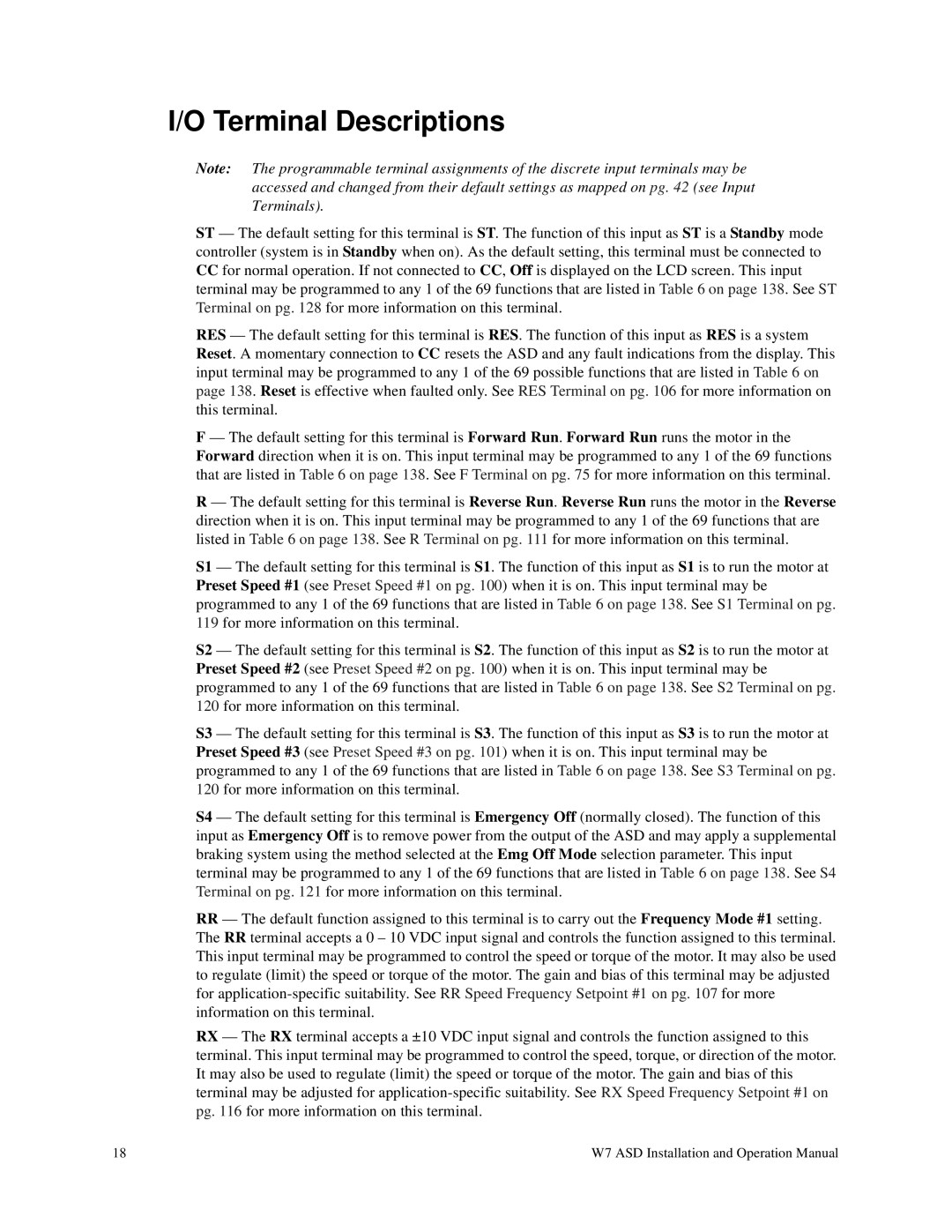I/O Terminal Descriptions
Note: The programmable terminal assignments of the discrete input terminals may be accessed and changed from their default settings as mapped on pg. 42 (see Input Terminals).
ST — The default setting for this terminal is ST. The function of this input as ST is a Standby mode controller (system is in Standby when on). As the default setting, this terminal must be connected to
CCfor normal operation. If not connected to CC, Off is displayed on the LCD screen. This input terminal may be programmed to any 1 of the 69 functions that are listed in Table 6 on page 138. See ST Terminal on pg. 128 for more information on this terminal.
RES — The default setting for this terminal is RES. The function of this input as RES is a system Reset. A momentary connection to CC resets the ASD and any fault indications from the display. This input terminal may be programmed to any 1 of the 69 possible functions that are listed in Table 6 on page 138. Reset is effective when faulted only. See RES Terminal on pg. 106 for more information on this terminal.
F — The default setting for this terminal is Forward Run. Forward Run runs the motor in the Forward direction when it is on. This input terminal may be programmed to any 1 of the 69 functions that are listed in Table 6 on page 138. See F Terminal on pg. 75 for more information on this terminal.
R — The default setting for this terminal is Reverse Run. Reverse Run runs the motor in the Reverse direction when it is on. This input terminal may be programmed to any 1 of the 69 functions that are listed in Table 6 on page 138. See R Terminal on pg. 111 for more information on this terminal.
S1 — The default setting for this terminal is S1. The function of this input as S1 is to run the motor at Preset Speed #1 (see Preset Speed #1 on pg. 100) when it is on. This input terminal may be programmed to any 1 of the 69 functions that are listed in Table 6 on page 138. See S1 Terminal on pg. 119 for more information on this terminal.
S2 — The default setting for this terminal is S2. The function of this input as S2 is to run the motor at Preset Speed #2 (see Preset Speed #2 on pg. 100) when it is on. This input terminal may be programmed to any 1 of the 69 functions that are listed in Table 6 on page 138. See S2 Terminal on pg. 120 for more information on this terminal.
S3 — The default setting for this terminal is S3. The function of this input as S3 is to run the motor at Preset Speed #3 (see Preset Speed #3 on pg. 101) when it is on. This input terminal may be programmed to any 1 of the 69 functions that are listed in Table 6 on page 138. See S3 Terminal on pg. 120 for more information on this terminal.
S4 — The default setting for this terminal is Emergency Off (normally closed). The function of this input as Emergency Off is to remove power from the output of the ASD and may apply a supplemental braking system using the method selected at the Emg Off Mode selection parameter. This input terminal may be programmed to any 1 of the 69 functions that are listed in Table 6 on page 138. See S4 Terminal on pg. 121 for more information on this terminal.
RR— The default function assigned to this terminal is to carry out the Frequency Mode #1 setting. The RR terminal accepts a 0 – 10 VDC input signal and controls the function assigned to this terminal. This input terminal may be programmed to control the speed or torque of the motor. It may also be used to regulate (limit) the speed or torque of the motor. The gain and bias of this terminal may be adjusted for
RX — The RX terminal accepts a ±10 VDC input signal and controls the function assigned to this terminal. This input terminal may be programmed to control the speed, torque, or direction of the motor. It may also be used to regulate (limit) the speed or torque of the motor. The gain and bias of this terminal may be adjusted for
18 | W7 ASD Installation and Operation Manual |
